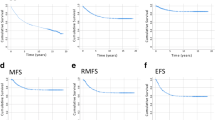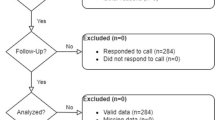PURPOSE
Actuarial and Product Limited (i.e., Kaplan-Meier) estimates of survival are commonly used in the literature to describe outcomes in patients treated for cancer. Terms such as cancer-specific and cancer-free survival are frequently quoted, although often without clear definitions. This study was designed to compare survival estimates using the Kaplan-Meier method on the same population of patients but using different definitions of what constitutes an event. This was to highlight some of the variation that can occur when different techniques are used to perform these calculations.
METHODS
Data were obtained from a prospective database that had recorded all patients presenting with colorectal cancer from 1996 to 2002. Using this information, we calculated the 1) overall (all-cause mortality), 2) cancer-specific, 3) cancer-free, 4) recurrence-free, and 5) relative survival (and 95 percent confidence intervals) at five years postpresentation.
RESULTS
The study included 497 patients with a mean age of 68 years, and a male-to-female ratio of 1.3:1. They were followed for a mean of 2.2 years (standard deviation, ±1.1), with 50 patients (10.1 percent) followed for more than five years. The various survivals at five years were: 1) overall survival, 55.6 percent (95 percent confidence interval, 49.1–62.1 percent), 2) cancer-specific survival, 67 percent (95 percent confidence interval, 60.9–73.1 percent), 3) cancer-free survival, 49.9 percent (95 percent confidence interval, 43.6–56.2 percent), 4) recurrence-free survival, 43.5 percent (95 percent confidence interval, 37.2–49.8 percent), and 5) relative survival, 73.4 percent (95 percent confidence interval, 65.4–81.4 percent).
CONCLUSIONS
The five-year survival calculations for this group of patients with colorectal cancer varied by as much as 30 percent depending on how the data was censored. This highlights that there needs to be a clear and accountable definition on how survival curves are calculated and presented in the literature to allow for meaningful interpretation and comparisons.




Similar content being viewed by others
REFERENCES
SJ Pocock TC Clayton DG Altman (2002) ArticleTitleSurvival plots of time-to-event outcomes in clinical trials: good practice and pitfalls Lancet 359 1686–9 Occurrence Handle10.1016/S0140-6736(02)08594-X Occurrence Handle12020548
R Peto MC Pike P Armitage et al. (1977) ArticleTitleDesign and analysis of randomised clinical trials requiring prolonged observation of each patient Br J Cancer 35 1–39 Occurrence Handle1:STN:280:CSiD1cjlsFc%3D Occurrence Handle831755
Armitage P, Berry G. Statistical methods in medical research. 3rd ed. London: Blackwell Science, 1994:469–92.
F Ederer LM Axtell SJ Cutler (1961) ArticleTitleThe relative survival rate: a statistical methodology Natl Cancer Inst Monogr 6 101–21 Occurrence Handle1:STN:280:CC2D3s%2FkvFA%3D Occurrence Handle13889176
T Hakulinen (1982) ArticleTitleCancer survival corrected for heterogeneity in patient withdrawal Biometrics 38 933–42 Occurrence Handle1:STN:280:BiyC2sbhsFw%3D Occurrence Handle7168796
J Esteve E Benhamou M Croasdale L Raymond (1990) ArticleTitleRelative survival and the estimation of net survival: elements for further discussion Stat Med 9 529–38 Occurrence Handle1:STN:280:By%2BB2szgtlc%3D Occurrence Handle2349404
Therneau T, Sicks J, Bergstralh E, Offord J. Expected survival based on hazard rates. Technical Report #52. Rochester, Minnesota: Mayo Clinic, 1994.
T Hakulinen L Tenkanen KH Abeywickrama L Paivarinta (1987) ArticleTitleTesting equality of relative survival patterns based on aggregated data Biometrics 43 313–25 Occurrence Handle1:STN:280:BiiB2s7ptFI%3D Occurrence Handle3607203
C Platell (1997) ArticleTitleA community-based hospital experience with colorectal cancer ANZ J Surg 67 420–3 Occurrence Handle1:STN:280:ByiA2sbotVM%3D
Author information
Authors and Affiliations
Corresponding author
Additional information
Reprints are not available.
About this article
Cite this article
Platell, C., Semmens, J. Review of Survival Curves for Colorectal Cancer. Dis Colon Rectum 47, 2070–2075 (2004). https://doi.org/10.1007/s10350-004-0743-4
Published:
Issue Date:
DOI: https://doi.org/10.1007/s10350-004-0743-4




